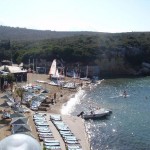 I’ve been away to Turkey on an activities holiday. It’s one way of counteracting that dreadful complaint ‘writer’s bottom’ and a good way of meeting new people. During introductions, it usually got round to what you do for a living. I decided to be bold and admit I write for children. The response was gratifying – it has to be said this was the middle classes at play – people were interested.
I’ve been away to Turkey on an activities holiday. It’s one way of counteracting that dreadful complaint ‘writer’s bottom’ and a good way of meeting new people. During introductions, it usually got round to what you do for a living. I decided to be bold and admit I write for children. The response was gratifying – it has to be said this was the middle classes at play – people were interested.
In particular, one family wanted me to chat to their son, Lewis, about his writing. As an ex-teacher, I couldn’t resist this appeal for help.
Now I have to admit this wasn’t entirely altruistic. I had taken my business cards and was quite happy to self-promote. As we all know, word-of-mouth is the best advertising. I had Kate Mosse’s voice in the back of my mind:
Never fail your constituency.
Not only that, but I have a viva voce to go before I complete my MA at West Dean and all practice is good. Explaining what I do and why clarifies things for me. As Frank Oppenheimer said:
The best way to learn is to teach.
So, not only did I enjoy reading Lewis’s high quality and instinctively dramatic work and the opportunity to hold forth, it was useful to me to examine what I had really learnt. Thus I am delighted to be asked by Greg Mosse to support the new MA students on a Tuesday: that’ll sharpen my ideas up.
It may be sentimental but the thought occurs to me that knowledge is like love – the more you share it about, the more you have.

 Today, 3rd September 2011, I went to
Today, 3rd September 2011, I went to


